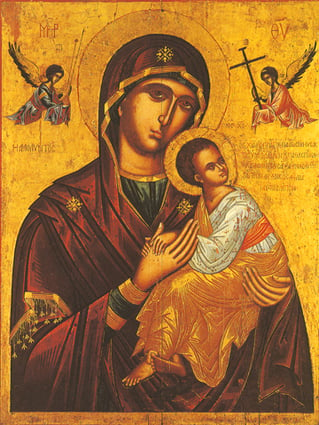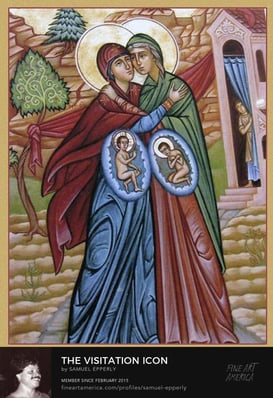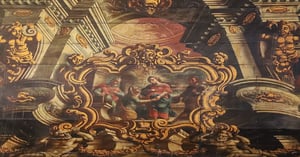Among all the manifestations of Christ’s Church, the Eastern Orthodox tradition has been the most gifted in the realm of visual symbolism. Beginning in the early centuries after Christ, Eastern iconographers crystallized doctrinal truths into pithy visual form. The Pantokrator icon (meaning “Ruler of All”), set the template for how most later Christians would imagine Jesus. Here, a dignified, bearded, long-haired Christ gestures in blessing. The Theotokos icon (meaning “God-bearer”) has been equally influential; it is the prototype for every image of baby Jesus on His mother’s lap. At Christmastime, we see echoes of the Theotokos on postage stamps, ornaments, and greeting cards.
 The Theotokos Icon, Public domain / via Wikimedia Commons
The Theotokos Icon, Public domain / via Wikimedia Commons
The Visitation
One lesser-known Orthodox icon shows the biblical event dubbed “The Visitation.” Here, Mary, having heard that Elizabeth was pregnant, has traveled to visit her cousin. According to the Scriptural account, the two women’s meeting caused the fetal John the Baptist to “leap” inside his mother. Across barriers of sense, space, flesh, and understanding, like called to infant like with instinctive, burbling joy. One imagines how the women must have laughed in surprise and happy sympathy.

In the icon version of this event, we see cross-sections of the mothers’ wombs. As Mary and Elizabeth demurely embrace, the infant Christ, naked yet regal, lifts his hand in blessing. The saintly John the Baptist, just opposite, crosses his arms and bows his head in reverence. This latter movement is not a “leap for joy,” to be sure, but perhaps it came at the moment after. Initial excitement gave way to a hush of awe; nearby greatness was intuitively and rapturously perceived.
The Nature of True Love
The world’s great romances tell stories of lovers drawn together like magnets, without calculation or premeditation, pulled into a dance of attractive forces like swirling atoms or binary stars. Our modern imaginations, drained of a rich heritage by shallow mass media and the worship of cynicism, understand this magnetic movement as primarily erotic. However, true love can take on an infinity of forms. It dwells at the center of God after all, where Father and Son, Creator and King, spiral in the love-dance of eons. And it dwells wherever the Holy Spirit calls out to itself, from surrendered heart to surrendered heart. These are places of true humility, open to receive sparks of divine beauty that not only fulfill their vessels but draw toward each other in search of a grander, collective fulfillment: in search, that is, of the Kingdom of God.
In the season of Advent, all the Christian churches nurture the Christ Child that grows within them, and on Christmas Day they join together to welcome His coming. First, they sing hymns of expectation—from North America to the Amazon, to Africa, to the Philippines. At the same time, they cooperate in works of charity, providing food and clothes and other gifts to Christ’s poor. Very often, they even display similar visual expressions of their rejoicing (wreaths, trees, creches, stars, lights). All over the world, and across institutional divides, they read the same Scripture and cherish the same hope within their hearts. They “embrace,” one might say, more than at any other time of year.
A Season of Visitation
For this is a season of Visitation—not only of visits to grandparents, shut-ins, or old friends but “visitations” of a deeper kind. This is a season when all Christians “visit” each other, in both flesh and spirit, through shared service, shared symbols, and even, sometimes, shared worship. At Christmastime, the innocent, hopeful, child-hearted Spirit that kindles each church calls out to itself with yearning, hoping for thrilling union (at last!) across all the fissures of doctrine and history.
This Advent, may we be richly aware of the delicate love that dwells inside us all, depending on us to carry it and bring it near to Itself—to its like—that it might leap for joy. May we be reconciled as people, as churches, and as nations, drawn together by the magnet-love that quickens, seeking its own, adorable image wherever it can be found.
Originally published on Christians Scholar's Review
Read Also:
Advent Meditation II: The Lady Listens
Advent Meditation I: St. Hildegard and the Cyclical Song of Angels

